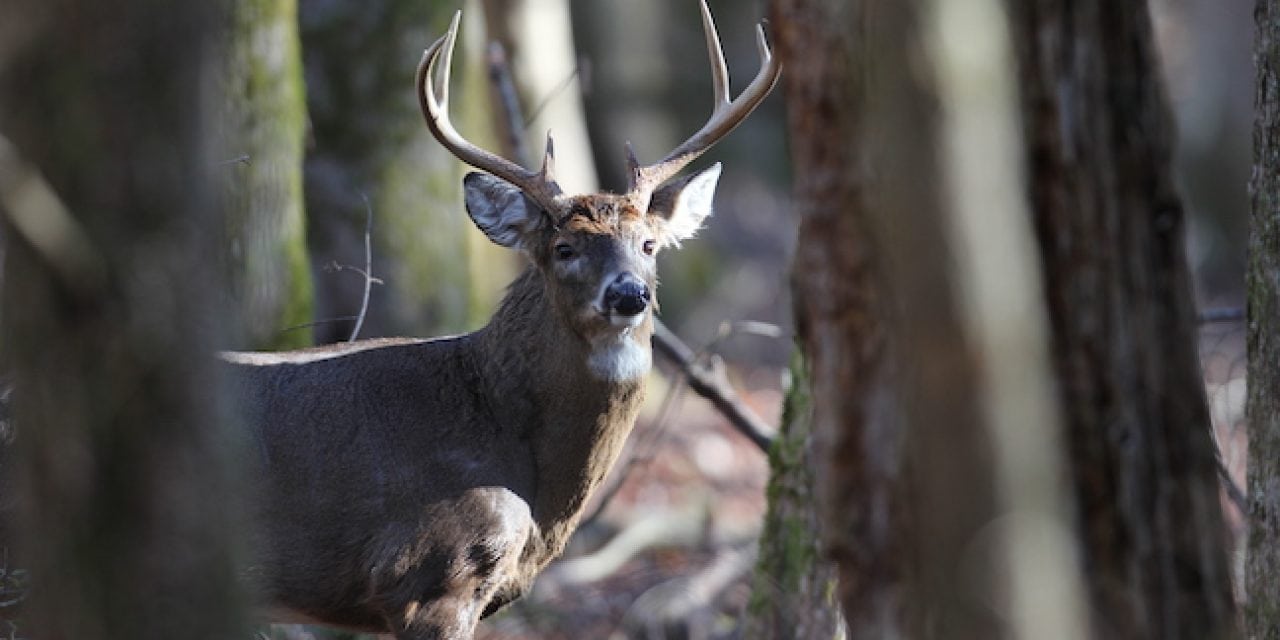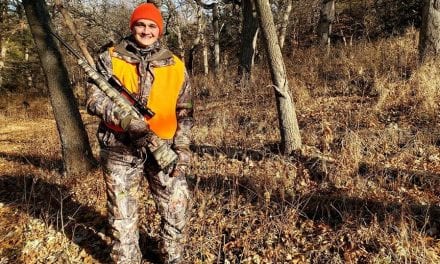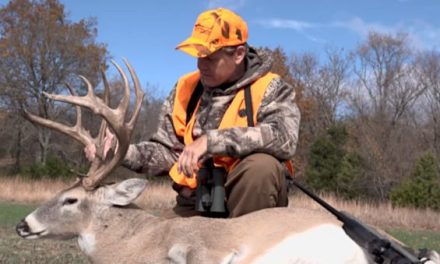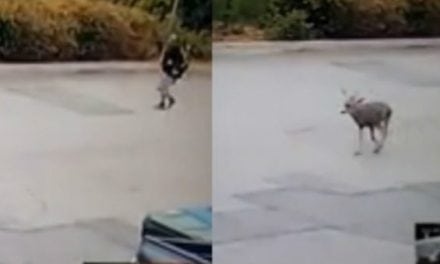Ideally, you want to bring a buck to you, but not all the way. Give him something else to think about with these deer tactics.
I was surprised at the sight of the buck in the narrow opening. The opening was one I watched for buck activity, but I felt if a deer did slide through the gap it would pause long enough for a shot.
I couldn’t have been more wrong. In a blurred whoosh the buck was there and gone in the blink of an eye.
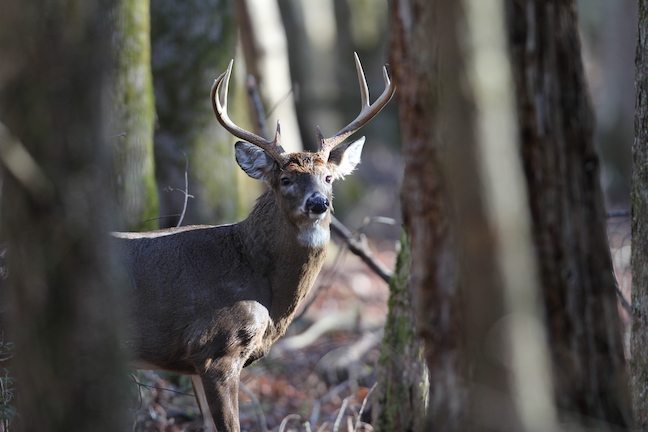
You’ll need to modify your ambush location to waylay a shrewd buck that uses cover as a cloak. (Photo by Ron Sinfelt)
Whitetail country includes a mix of fields and forests. Unfortunately, if you target mature bucks, you’ll seldom see them prancing across open fields once hunting season kicks off.
You’ll need to modify your ambush location to waylay a shrewd buck that uses cover as a cloak to veil movements until darkness frees its open-country inhibitions.
That means you may only have a second or two to get a shot off in a narrow shooting lane. Don’t blink.
Instead, grab a buck’s attention to make it pause where you want it and long enough for an accurate shot. Put these attention-getting strategies to use in your whitetail woods this season.
SCENT STOP SIGN
You have 5 million or more olfactory chemoreceptors in your upper nose. These are situated on a postage-stamp-sized mucous membrane that detects airborne chemicals and the ability to distinguish more than 10,000 separate smells.
Nevertheless, whitetails do it better.
According to research from the University of Wisconsin Stevens Point, whitetails have a longer olfactory system to analyze scent more efficiently with 60 times as many olfactory sensors as you have. Use a buck’s sniffer to stop it where you want it.
Mock scrapes top the list. You can set that trap in late summer, fall or on the spot.
To keep it activated without your presence, use a temperature-activated dripper. Set up the mock scrape upwind of your ambush site and in the exact opening you want a buck to pause.
As deer pass they will be tempted to stop and investigate other “perceived” visitors in the area.
If you embrace a scent-free hunting style then you can sneak over and create another reason for a buck to pause at a scrape, real or faux. Cover it up.
By kicking leaves and dirt to cover the scrape it spurs a buck into re-opening the scrape, again causing the buck to stop where you want it.
Of course some hunts keep you moving with ambush setups occurring when you see the “right” location.
Keep a bottle of deer urine handy that is topped with a powerful spray nozzle. This gives you freedom to cast a buck-stopping bouquet where you want to pause a buck.
Make sure your dispenser generates a mist stream a yard or longer to guarantee you can spray across a trail or opening without physically crossing it.
Look for nose-high vegetation on the far side of the trail and mist it lightly. Too much may cause fear, but a couple of bursts of scent creates curiosity that can make a buck hit the brakes.
Finally, if you forgot to make a mock scrape and brought no scent, simply scrape out a fresh area of dirt, the larger the better. The smell of fresh dirt is often enough to bring a buck to a screeching halt in the opening where you create it.
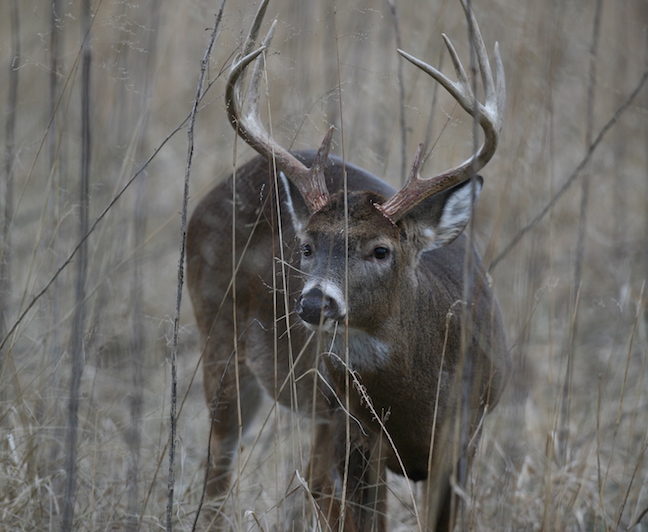
(Photo by Ron Sinfelt)
THE SMELL OF CEDAR
Bucks begin rubbing trees in September to remove velvet and eventually to engage as sparring partners.
They continue rubbing throughout the fall to strengthen neck muscles and to vent rutting frustrations. You can add in your own rub right where you want a buck to stop with a bit of pre-season foresight.
First, determine what trees bucks like to rub on and if there is the possibility to harvest those trees. If so, place a fresh-cut, post-sized one in your chosen spot. (Ignore this option if you hunt public land.)
That works especially well on a property that is overgrown and may need a forester’s touch.
If you’re struggling to determine which tree to use, focus on aromatic trees and those with soft bark. Both have been researched and attract bucks for rub attention.
Favorites include aspens and cedars. During your pre-season scouting forays, investigate all rubs, inventory them and determine the species of tree for your best option.
If cutting a tree of 4 to 6 inches in circumference seems problematic, just head to your local home improvement center or lumberyard. You likely have seen treated fence posts and telephone posts being used as whitetail rubs. Purchase a cedar fence post or two to plant at your hunting site.
You can use a hand-powered or motorized auger to dig a hole upwind of your ambush location. Add some Quikrete into the hole to ensure it won’t budge under the power of a buck in fight mode.
And you don’t need to stop with just one post. If you want to alter travel, string the posts out in sight of one another with the largest diameter post cemented squarely in the shooting lane of your choice.
When a buck enters the opening, it will be sparked to visit the post, sniff it and maybe even give it a shove.
TRAIL DETOURS
Not every ambush location includes a manicured opening. If you’re hunting strictly trails in dense cover you may need to do some roadwork. In brief, you may need to create a detour or roadblock to make a buck pause for a shot.
You likely stop daily for traffic detours as you drive to and from work. You can make a deer do the same with a few minutes of work and utilizing natural debris found at the hunting setting.
Some trails are easy to manipulate, such as a single trail past your ambush location. It may just require a narrowing of the trail to make deer pause and take notice of just how to maneuver through the tangle.
Using limbs, branches, logs and even portable livestock fences you can also block adjoining trails and make your trail the obvious route.
That’s ideal for most hunting locations since they usually include a series of trails all going to the same location. Permanently close one trail to force bucks to the trail of your choosing.
Once you have coordinated the traffic flow past you, add in just enough obstructions to make a deer pause. Create sudden turns, narrow the trail or put up a barrier that makes a deer duck under, or snake around, to complete its journey.
The best shooting opportunity forces any passing deer to quarter away at some point during the encounter. When the buck hits the corner and focuses its vision away from you, it’s time for you to shoot.
And of course, you can always add in a misting of scent at those corners or obstructions to guarantee a buck-stopping moment.
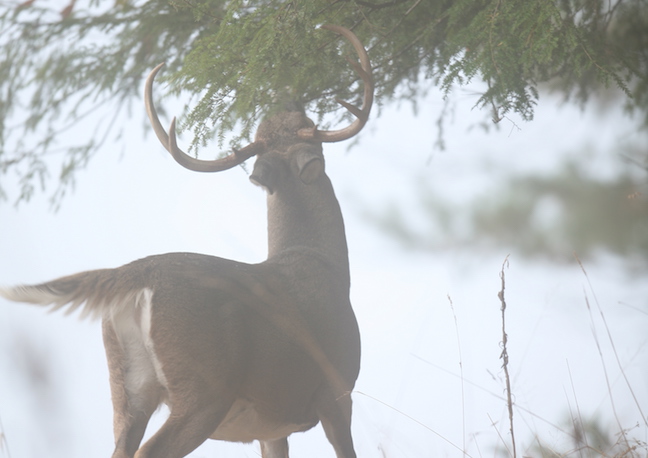
(Photo by Ron Sinfelt)
FAST FOOD
Food grabs the attention of everybody and deer are no different. That noted, consider food as a stopping element away from major feeding fields.
You can scout out locations such as a mast-heavy ridge with a cluster of oaks. Old orchards hidden within the timber can also be targeted for a buck-stop location.
To guarantee putting a buck where you want it, consider adding in a forest food plot.
Old roads, abandoned trails and small openings that produce partial sunlight during the day are ideal locations. Research seed mixes that will prosper in your location under such conditions, such as clovers.
Next, scratch out a food plot prior to the season. Add in seed, fertilizer and a dose of prayer for rain to finish the chore. By the time hunting season arrives, the small plot may have big attraction to bucks passing by looking for fast food.
Check your state regulations regarding the next option.
Approximately half of the states east of the Mississippi River allow the use of supplemental feed, or “bait,” while hunting. There’s no need to don your farming bibs. You can simply place food in an opening, and there’s a high probability that deer passing by will at least pause to see if other deer are in the neighborhood. Most will saunter over for a quick lunch.
Mineral sites have equal appeal and stopping power, particularly in areas that are mineral challenged. Research products with calcium and phosphorous in a 2-to-1 ratio.
Both are essential for antler and bone growth. Many also include additional vitamins and minerals that boost a deer’s immune system, plus maximize genetic potential.
Your mineral site doesn’t need to be anything fancy. Some land managers use mineral dispensers, but dumping them on the soil allows deer to paw and lick for benefit. If you feel the deer are not using minerals, simply add trace salt and the visitation will increase.
One season found me hunting a willow-choked oxbow with sight windows less than 100 yards long and with gaps smaller than a New York City parking space.
From deer sign I could tell one trail was receiving more attention than all the others combined so I went to work putting in a mock scrape with a scent dispenser.
Opening weekend was my first chance to get back and check the scrape. My flashlight told a tale of heavy visitation.
I climbed into my stand to wait. An hour after sunrise I made out the shape of a buck moving my way through the morning fog.
It doesn’t always happen this way, but the buck followed my plan like a scripted Hollywood movie and walked right to the scrape for an inspection.
I barely let him take the first whiff when I ended my hunt with the help of a buck attention-getter and some Hornady knock-down power.
The post Deer Tactics: Attract Your Buck (Then Distract Him) appeared first on Game & Fish.

